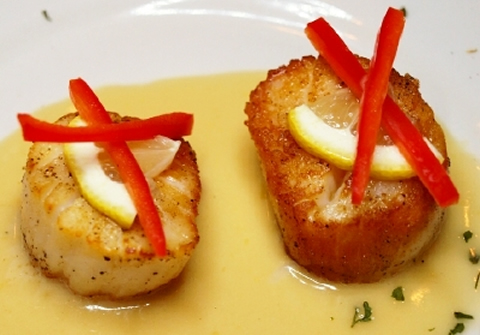
Our annual survey of seafood in Southeast Louisiana this year counts down the 33 best seafood species enjoyed in our restaurants, seafood markets, and homes. For the full survey so far, click here. Or use the links at the bottom to move up and down the list.

#8: Sea Scallops
Sea scallops have become omnipresent on local menus, even though they come from waters far away from New Orleans. Air shipping of seafood makes it possible for us to enjoy fresh scallops in our restaurants, and sometimes even from our grocery stores.
Unfortunately, we're also still getting the not-so-fresh scallops, too. Like as not, those are the ones you'll see in the supermarkets. More on that--and the little bay scallops, too--later.
Back to the good news. The best sea scallops are the big ones. They come from the Atlantic in the same parts of the Northeast that give us good lobsters. They range in size from about an inch across to the size of a petite filet mignon. Scallops, like most mollusks, veer from the general seafood rule that smaller is better. I find the biggest ones most interesting.
The scallops you've enjoyed in the best restaurants are gathered and shipped with better-than-average care. They're known generically as"dry-pack" scallops, meaning they have not been immersed in a preservative chemical. "Day-boat" scallops (gathered in one day's fishing and rished to market) or "diver" scallops (actually gathered by divers instead of dredges) are the best of the dry-pack scallops. These have the superb sweet flavor of fresh shellfish, with just a light searing at the outside. (They should bulge at the sides when cooked.) They're also good raw as sashimi.
The part of the scallop that we eat is analogous to the eye of an oyster. It's the adductor muscle, the one that keeps the shell closed. Only rarely do you see the entire surrounding tissue left intact. If you try that, you learn why we only eat the white part.
Before cooking at home, wash scallops exceedingly well. They sometimes contain fine sand. It's disconcerting to enjoy the flavor of a scallop and then be put off by a gritty sensation in chewing. Even in good restaurants I find this now and then.
Once in a very great while, scallops have the orange roe sac attached. Depending on which chef you ask, this is either wonderful or something to be got rid of. I like it, perhaps as much for its rarity than its intrinsic goodness.
Unacceptable Alternatives. The little bay scallops are about the size of miniature marshmallows. Although they are prized in the Boston and Cape Cod area when they're fresh in season, almost all bay scallops you're likely to find have been either frozen or treated with a phosphate chemical that extends their shelf life. Acceptable for people who go to places like Red Lobster (which sells tons of them), but nobody who really knows seafood.
As for the bigger sea scallops, most what you see in stores were dredged up from the sandy sea bottom and processed by what amount to floating factories. The phosphate chemical enters the picture, extending the length of time they can be sold at retail but giving a chemical taste and a strange texture to the teeth. Not only that, but the chemical is so effective that sometimes you can't get the treated scallops to brown, no matter how hot the pan is.

Cajun Seared Scallops With Near-Guacamole
Save this recipe for occasions when you find those sea scallops that are almost the size of filet mignons. Sea scallops that size are wonderful, and lend themselves particularly to pan-searing. In our part of the world, this verges on blackening, and that's just fine, assuming the pan is really hot and you don't let the scallops sit there too long. They should bulge after cooking.
The salsa is essentially my recipe for guacamole, but with the avocados sliced on top instead of blended in.
- 1 lb. sea scallops, the bigger the better
- Creole seasoning
- Salt
- 1/2 stick melted butter
- Sauce:
- 2 tomatillos, peeled and chopped
- 1 medium sweet onion, chopped
- Juice of one lime
- 1 Tbs. red wine vinegar
- 1 Tbs. olive oil
- 2 tsp. Tabasco jalapeno pepper sauce
- 2 large ripe tomatoes, skinned and seeded, chopped
- 1/4 tsp. salt
- 1/4 tsp. coarsely-ground black pepper
- 2 tsp. Vietnamese fish sauce
- 2 Hass avocados, ripe but not soft, sliced into 8-12 slices each
- 8 sprigs cilantro, leaves only, chopped
- 1 green onion, tender green part only, sliced
1. Heat a black iron skillet over high heat.
2. Check the sea scallops to make sure they've been well trimmed (sometimes you''ll find some fibrous stuff at the edge). Coat the sea scallops generously with Creole seasoning and a little salt. Roll them through the melted butter and put them, still dripping, into the hot pan. Cook them for about a minute on top and the bottom. (Don't cook the sides.) They're ready when they're distinctly brown but still bulging at the sides.
3. Combine all the sauce ingredients up to the avocados in a food processor. (You can use that to do the chopping.)
4. Spoon about 1/4 cup of the sauce onto the plate. Place four to six scallops on the plate (depending on size). Put the avocado slice between them. Garnish with chopped cilantro and green onions.
Serves four.